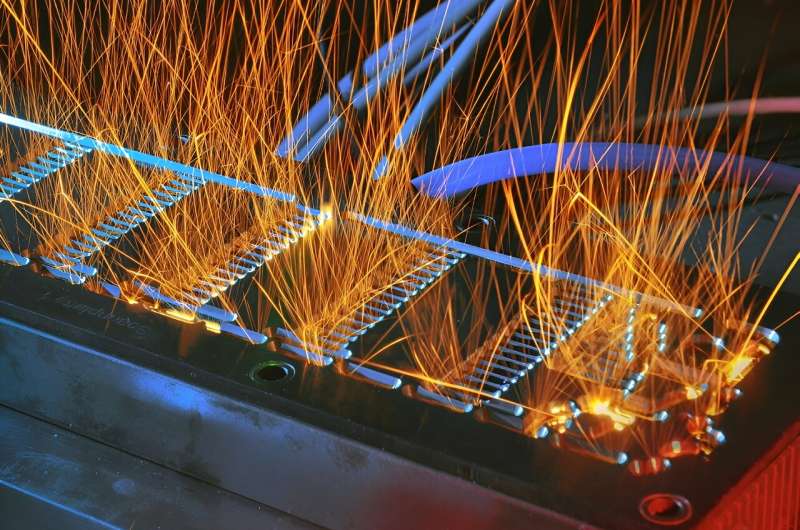This article has been reviewed according to Science X's editorial process and policies. Editors have highlighted the following attributes while ensuring the content's credibility:
fact-checked
proofread
Developing new approaches for the cost-efficient and high-speed production of fuel cells

For hydrogen technology to become a key to the energy transition, it needs to take a decisive step forward toward broad application. The main factors holding back this longed-for breakthrough, however, are the high costs of expensive materials and complex manufacturing processes for fuel cells and electrolyzers.
The Fraunhofer Institute for Laser Technology ILT is tackling these challenges and working hard to develop cost-efficient and scalable solutions. At Hy-fcell 2024 in Stuttgart, the Aachen-based institute will be presenting pioneering innovations in Hall 4, Stand 4E51, transformations that help to make production processes considerably more economical and sustainable at the same time.
Laser-based drying of electrodes: Energy efficiency, speed and space savings in fuel cell production
As the demand for fuel cells grows, it is becoming increasingly important to make production processes more efficient. Yet, a key challenge remains: drying the wet-applied electrode layers for the membrane electrode assembly (MEA) in the polymer electrolyte membrane (PEM) fuel cell. Conventionally, this process is carried out in large convection ovens, which consume a great deal of energy and take up considerable space in a production hall.
Fraunhofer ILT has developed a laser-assisted drying technology that addresses these issues. The use of lasers, which expose the electrodes selectively, reduces the drying time from several minutes down to just a few seconds. This drastic reduction in drying time significantly increases production speed, particularly in the roll-to-roll process.
Furthermore, this process reduces energy requirements compared to conventional gas-powered continuous ovens. In addition, the laser system requires considerably less space, which enables a more compact and flexible production line.
"By developing a laser-based roll-to-roll process for the production of membrane electrode units, we are taking an important step towards making fuel-cell manufacturing processes more efficient. With our laser-assisted drying technology, we are setting a new standard that not only increases production speed, but also optimizes energy efficiency and space utilization," explains Manuella Guirgues from the Thin Film Processing group at Fraunhofer ILT.
Corrosion protection coatings for bipolar plates: Increasing efficiency and reducing costs in fuel cell production
Particularly with PEM fuel cells, the aggressive chemical conditions within the fuel cell pose new challenges for production. Protecting the metallic bipolar plates (BPP) from corrosion is not only essential for the service life of the cell, but also for the efficiency of the entire fuel-cell stack.
When BPPs are coated with chemical or physical vapor deposition in a vacuum, costs rise and production slows down. Fraunhofer ILT is working on a process that combines spray coating with laser-beam processing in order to achieve an electrically conductive and corrosion-resistant finish on the metallic bipolar plates—without the need for an energy-intensive vacuum process.
This approach can not only significantly reduce production costs through the use of cost-effective materials, but also be better integrated into continuous manufacturing processes. The high scalability of the process helps to efficiently serve the growing market for PEM fuel cells.
Julius Funke from the High Temperature Functionalization group emphasizes, "Our laser-based method for the production of corrosion protection layers offers an efficient and cost-effective alternative to traditional vacuum processes. It enables faster production and improved scalability, which is crucial to meet the increasing demand for PEM fuel cells."
Optimization of fuel cell production through double-beam welding and repair of forming tools
Double-beam welding can also be used to speed up production elsewhere. This process uses two laser beams simultaneously to weld the metallic bipolar plates, a technique that reduces the cycle time by almost 50% without compromising the seam quality.
When the two beams are used to weld at one point, the melt pool dynamics can be influenced selectively, enabling higher welding speeds and avoiding typical defects such as humping. This process enables faster and more efficient production that meets the increasing demands of hydrogen technology.
The production of metallic BPPs is also hampered by the service life of the tool steels used. The tools are susceptible to wear due to their high mechanical loads. The approach taken by ILT is to replace cost-intensive tool steels with structural steels and to apply high-quality wear protection coatings using extreme high-speed laser cladding (EHLA).
Compared to conventional tool steels, the coated workpieces exhibit an increase in sliding friction wear resistance by a factor of more than 10. The EHLA process also allows damaged areas of the tools to be repaired, enabling the tools to be adapted and reused. This technology significantly extends the service life of the tools, which in turn reduces production costs and increases sustainability in manufacturing.
Fraunhofer ILT is developing a number of processes to make the process chain for manufacturing fuel-cell components more efficient. These include high-speed cutting, with which the BPPs are precisely trimmed and media feed holes are cut directly.
An innovative approach is the laser-based introduction of microstructures into the metallic BPP, which reduce the electrical contact resistance and displace the water from the contact zone during operation of the fuel cell.
The Aachen researchers are also intensively investigating the structuring and welding of compound BPPs and MEAs in order to further automate the production of fuel cells and make it more efficient.















